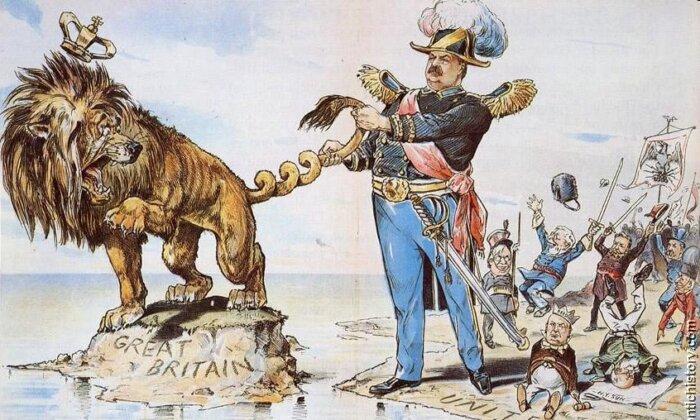In 2013, then U.S. Secretary of State John Kerry announced, “The era of the Monroe Doctrine is over.” He couldn’t have been more wrong. More on that in a bit.

Monroe’s Dec. 2, 1823, State of the Union Address, which is 6,397 words long, dwelt on domestic issues, including the state of public finances. Yet its 954 words (three paragraphs) on foreign affairs, with ideas on republicanism, nonintervention, patriotism, anticolonialism, and nationalism provoke thought even today. In terms of sheer pluck, amid European monarchical and imperial dominance, it was, as Mr. Sexton puts it, akin to “the hitchhiker dictating directions to the driver.”
Mr. Sexton sums up the doctrine as one that “unilaterally asserted that ‘the American continents, by the free and independent condition which they have assumed and maintain, are henceforth not to be considered as subjects for colonization by any European powers.’” When America’s federalism was yet to establish itself, European intervention felt threatening because, Mr. Sexton says, Monroe “linked foreign dangers to internal vulnerabilities.” Colonial Europe’s roving eye might “inflame domestic conflict” threatening the union from within.
But Mr. Sexton warns against projecting modern understanding back onto early history because American nation-building of that era was too complex to capture through sweeping political theorizing; each state was almost a nation unto itself.

So, the Monroe Doctrine isn’t a tablet of stone, scrupulously followed by Monroe’s successors. It’s a living, breathing philosophy, absorbing and accommodating geopolitical changes, challenges, and compulsions. In a sense, Monroe didn’t create a “doctrine.” That would be left to later Americans, competing and arguing as they laid claim to the mantle of 1823. Besides, it was co-drafted by John Quincy Adams, John C. Calhoun, and William Wirt. It was a product of collectively perceived threat and aspiration.
Americans had no intention, as Kentucky statesman Henry Clay feared in 1820, of remaining, as Mr. Sexton states, “independent colonies of England—politically free, commercially slaves.” What followed was a delicate balancing between Anglophobia and Anglophilia (anti-English versus pro-English) on one front and between union at home (states jostling in the wake of the American Revolution) and independence abroad. America’s foreign and domestic components were, as Mr. Sexton says, “halves of the same whole.”

Mr. Sexton explains that the doctrine shaped history bidirectionally. Horizontally, it became “American shorthand for a hemisphere (and, ultimately a world) cleared of the British Empire.” Vertically, it heralded America’s assertiveness in the global north.
Mr. Sexton clarifies that the final paragraph of the 1823 message “rarely considered part of the Monroe Doctrine, celebrated the American tradition of expansion” but stopped short of an overt call for expansion. Monroe’s successors, James K. Polk, Franklin Pierce, and James Buchanan, to name a few, interpreted the doctrine as a call for an aggressive or expansionist foreign policy. The Lincoln administration never invoked the doctrine with the British or the French but made clear that pro-Confederacy acts on their part would be considered hostile to America.
So, the doctrine of the late 19th and early 20th centuries owed more to the Civil War era than to, as Mr. Sexton states, “the increasingly distant world of 1823.” Over time, policymakers invoked it on behalf of policies that went beyond “the limited and ambiguous course articulated by Monroe himself.” What’s more, successive Senate debates linked it not with a political party or with specific individuals, but with a broader Americanism.

Eventually, this bred an explicitly interventionist Corollary of the Monroe Doctrine, a version 2.0 of sorts, under Theodore Roosevelt in 1904. No one applauded that more than Britain, a vastly diminished 20th-century force, now spared responsibility as protector-defender, in a hemisphere it had no longer the power to police. A more assured America had taken on that mantle.
A Doctrine for the 21st Century?
Mr. Sexton’s conclusion attempts to contemporize the document, albeit too briefly. Perhaps that’s for another book: how the Monroe Doctrine shaped and still shapes contemporary statecraft. Regardless, it would be wrong to imagine that it’s an anachronism, belonging only on the bookshelves of historians.This resolution doesn’t wallow in platitudinal homage. Unlike the doctrine it salutes, the resolution calls for action, even as some pacifists are calling for a watering down, if not a rewriting, of the doctrine, and as some combative others are issuing a contrarian cry, for Russia and China to develop their own analog and to forbid U.S. presence on the continent of Eurasia.
Ten years after Mr. Kerry prematurely announced the obituary of the Monroe Doctrine, it appears that its time is far from over.








